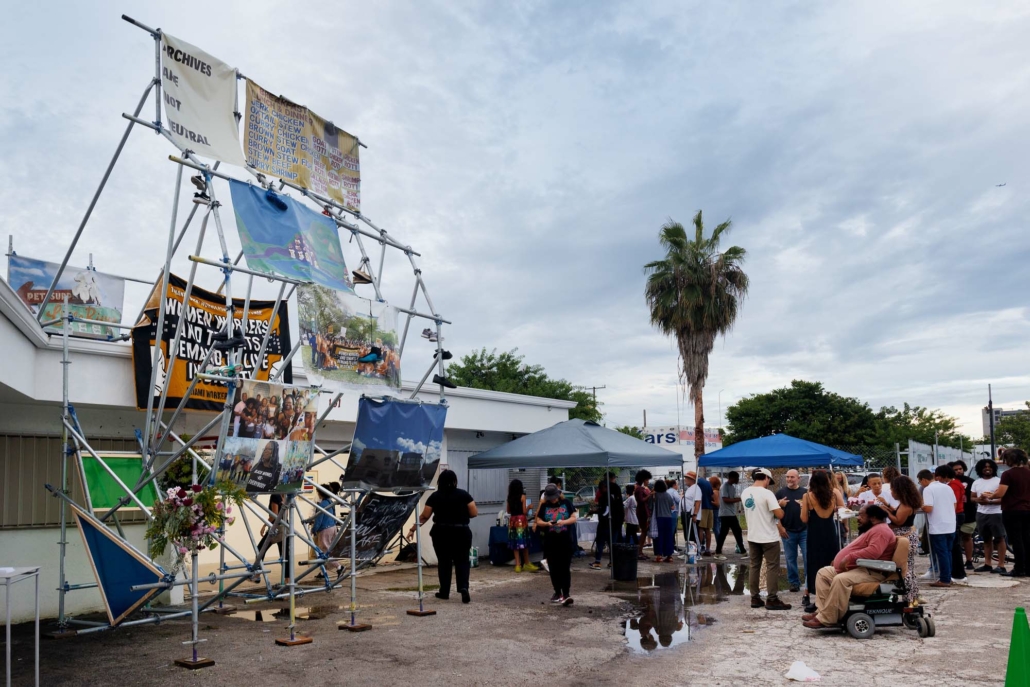Provisional Obstruction: A portal to displaced futures in Little Haiti
The scaffolding is speculated to be a structure as old as some of the oldest of civilizations, rising and collapsing with increasing rapidity through time — as other technological advances started aiding its ambition — forming the backbone of ancient and neo-imperial development and human colonisation of the surface of the planet. The universality of this temporary structure, permanent in the human imagination, is where artists Ayesha Singh and misael soto converge their practices, which individually always maintained preoccupations with built structures, for the first time in Pilsen, Chicago, as the continuing series Provisional Obstruction. Constantly mutable and ever expanding city scapes are pared down to its building blocks, to the scaffolding as a tool, structure and framework, waiting to be rewritten and reclaimed, albeit gesturally, in each city that hosts it.
Provisional Obstruction (Little Haiti II) (2022) by misael soto and Ayesha Singh
—
Outside the gallery and artists studios, Dimensions Variable, located in Little Haiti, where soto has been maintaining their studio since the summer of 2021, arose a scaffolding from 6 August – 18 September 2022, tipped over sideways to resemble the mast of a ship, or a gigantic wave, reminiscent of the impending rise in ocean levels that threaten to engulf the shores of Miami and the wealthy beach facing neighbourhoods. Secured to it initially were short lengths of flexible metallic panels mirroring the area they faced. Little Haiti is historically home to some of the most marginalised communities of Miami, a city that arguably has only favoured its upper-classes, and is located on a ridge that is the highest geological formation above sea level in the city, making it hotly sought after by property developers in the face of assured consequences of the climate crisis. As the sights and sounds of the locality transform swiftly, at a pace comparable in historical time to the view from the window of a moving train in measured time on the rail line that marks the elevated ridge on a map, this fast gentrifying neighbourhood is now also home to creative communities that moved there for cheaper rents, many of whom also contributed to Singh and soto’s project. Rather than a literal attempt at destabilising the marker of change to the locality’s skyline, the scaffold that lies on its side seems to gesture outside of linear time, not to the future or to the past, but to interrupt time and take it to an elsewhere, a place where new imaginations may take hold and reorient the fate inscribed by instruments of power over whom neither the artists nor the community have any sway.
The negative spaces carved by the form of the scaffolding — that is arguably a reductive, rather dry, facade when compared to the seductive promises of capital — become blank canvases against the sky upon which, in Little Haiti, living aspirations of communities that inhabit it were draped and projected, gradually concealing abstracted reflections of the present space/time of the site during the course of the project. Gathered through conversations with people for whom displacement is an imminent and everyday threat, the artists’ process engenders conviviality and camaraderie as ways of speculating upon generative alternatives. The prompts—images, artworks, and performances—memorialise diverse histories that are being erased in the process of rapid gentrification, inviting remembrances as acts of resistance.
Provisional Obstruction (Little Haiti II) (2022) by misael soto, Ayesha Singh, and community collaborators
—
As an ally and friend to the politics and socialites maintained by the project, I have been following its various interpretations and experiments over the years, and it is with Little Haiti II that the project cohesively realised the purpose and confidence that it always embodied. Nostalgia has perhaps always been an aesthetic and political device present within all iterations of Provisional Obstruction. In earlier interpretations, digital prints made by the artists to be draped on the scaffolding, of architectural elements that have long lost their purpose but continue to recur as aesthetic tropes signifying collective historical memory of grandeur and power, and extended arms of the scaffolding to sculpturally disrupt space to evoke the bodily memory of interacting with functional scaffoldings, were some of the carriers of nostalgia. While these interventions to the original form of the scaffolding played with the memorised responses of their audiences to the various components that collaborate within it, these artistic prompts have always been one way to generate conversations with people affected by transitioning urban spaces. Yet, this is the first time that the project extended its own ambitions to yield space directly for communities, not just by means of conversations, but by inviting them to take over the structure proposed by the artists and rebirth it in their own imagination. This ostensibly minimal but crucial difference resurrects the latent nostalgia that stagnated as a formal device in the project as a generative space for reflection, resistance and remembering of possible futures that were cut short by redevelopment. By removing focus from what would come to take its place, Provisional Obstruction Little Haiti II locates its gaze upon a time that never came to be, through totemic cultural presences of the past or soon to be past that were not or will not be allowed to continue, and remains hopeful of that the community’s envisioned futures may be realised, even if not in their lifetimes.
The sideways glance of the scaffolding—nostalgia too is directed sideways, as Svetlana Boym observes in the introduction to The Future of Nostalgia—opens up a portal from the residual scar tissue left behind by futures that were severed and discarded from linear time. And this portal to the self-determined desires of the community holds space for these alternative futures to be rehabilitated, celebrated or perhaps even mourned. And in this collective act of remembering, new resilient possibilities may emerge. When asked whether they identify this work as social practice, they respond by referring to the interventions encompassed by Provisional Obstruction as “just what good neighbours do.” The care, sensitivities and friendship maintained by the project reiterates this. Even as Provisional Obstruction Little Haiti II might just be a blip in the neighbourhood’s steadfast journey in the direction charted by the global condition of limitless accelerationism, it creates a vital space for its addressal by communities grappling with debilitating changes to what they consider to be their home.
Anushka Rajendran
Anushka Rajendran is the curator of Prameya Art Foundation (New Delhi) and also works independently as a curator and writer. Her ongoing curatorial research traces how the notion of public has acquired alternative significance to contemporary art in recent years, as well as the aesthetics of engagement within exhibition frameworks. This is informed by her previous research on responses by artists living in India in the 1990s to political and cultural trauma which has since expanded to encompass the South Asia region. She was the Festival Curator for Language is Migrant, the 2022 edition of Colomboscope, the only interdisciplinary arts festival in Sri Lanka and was on the curatorial team for Kochi Muziris Biennale 2018. Other recent projects include, Like Cupping Water with their Hands, PRAF at Focal Point, Sharjah Art Foundation, 2022 (Sharjah, UAE); Language is Migrant, Warehouse421, 2022 (Abu Dhabi); Phantasmapolis: Looking Back to the Future, Asian Art Biennial 2021-22, National Taiwan Museum of Fine Arts, 2021 (Taiwan); And yet the air was still stirring, Fundación Sandretto Re Rebaudengo Madrid, 2021-22 (Spain); Anatomies of Tongues, Chobi Mela Shunno, 2021 (Dhaka); Speculations on a New World Order, Shrine Empire, 2020 (New Delhi); and Between the Lines, Aomori Contemporary Art Centre, 2019 (Japan). She has published essays in several publications including anthologies, academic journals and artists’ monographs. At the moment, she is editing the publication, Twenty Years of Britto (published by Steidl and supported by Documenta) which looks back at the vital work and legacy of Britto Arts Trust (Bangladesh), and also a monograph on Anoli Perera’s life and work.












